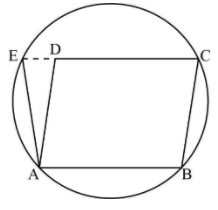
Answer
466.2k+ views
Hint: In the solution we will use the property of a quadrilateral. The property used in this problem is that opposite angles of the cyclic quadrilateral is supplementary.
Complete Step-by-step Solution
The circle through points A, B and C intersects CD at point E.
The following is the schematic diagram of the parallelogram.

In the cyclic quadrilateral ABCE the sum of angle is,
$\angle AED + \angle ABC = 180^\circ $……(i)
Also, we know that the opposite angles of a quadrilateral are supplementary.
$\angle ADE + \angle ADC = 180^\circ $
Since, from the linear pair axiom theorem which states that when a ray stand on the line then, addition of two adjacent angles will be equal to $180^\circ $. We know that the angle $\angle ADC$ is equal to $\angle ABC$.
On putting angle $\angle ABC$ for $\angle ADC$ in the above expression.
$\angle ADE + \angle ABC = 180^\circ $…….(ii)
On equating equations (i) and (ii).
$\begin{array}{c}
\angle AED + \angle ABC = \angle ADE + \angle ABC\\
\angle AED = \angle ADE
\end{array}$
Now, in the triangle $\Delta ADE$the sides AE and AD are equal because angle $\angle AED = \angle ADE$ are equal.
Therefore, it is proved that \[AE = AD\].
Note:In solving such types of problems, make sure to learn the property of a triangle and quadrilaterals. The one of the most important point is that while applying the linear pair axiom theorem, students should be careful about the sum of adjacent angles which is $180^\circ $ not $360^\circ $.
Complete Step-by-step Solution
The circle through points A, B and C intersects CD at point E.
The following is the schematic diagram of the parallelogram.

In the cyclic quadrilateral ABCE the sum of angle is,
$\angle AED + \angle ABC = 180^\circ $……(i)
Also, we know that the opposite angles of a quadrilateral are supplementary.
$\angle ADE + \angle ADC = 180^\circ $
Since, from the linear pair axiom theorem which states that when a ray stand on the line then, addition of two adjacent angles will be equal to $180^\circ $. We know that the angle $\angle ADC$ is equal to $\angle ABC$.
On putting angle $\angle ABC$ for $\angle ADC$ in the above expression.
$\angle ADE + \angle ABC = 180^\circ $…….(ii)
On equating equations (i) and (ii).
$\begin{array}{c}
\angle AED + \angle ABC = \angle ADE + \angle ABC\\
\angle AED = \angle ADE
\end{array}$
Now, in the triangle $\Delta ADE$the sides AE and AD are equal because angle $\angle AED = \angle ADE$ are equal.
Therefore, it is proved that \[AE = AD\].
Note:In solving such types of problems, make sure to learn the property of a triangle and quadrilaterals. The one of the most important point is that while applying the linear pair axiom theorem, students should be careful about the sum of adjacent angles which is $180^\circ $ not $360^\circ $.
Recently Updated Pages
10 Examples of Evaporation in Daily Life with Explanations

10 Examples of Diffusion in Everyday Life

1 g of dry green algae absorb 47 times 10 3 moles of class 11 chemistry CBSE

If the coordinates of the points A B and C be 443 23 class 10 maths JEE_Main

If the mean of the set of numbers x1x2xn is bar x then class 10 maths JEE_Main

What is the meaning of celestial class 10 social science CBSE

Trending doubts
Fill the blanks with the suitable prepositions 1 The class 9 english CBSE

Which are the Top 10 Largest Countries of the World?

How do you graph the function fx 4x class 9 maths CBSE

Who was the leader of the Bolshevik Party A Leon Trotsky class 9 social science CBSE

The Equation xxx + 2 is Satisfied when x is Equal to Class 10 Maths

Differentiate between homogeneous and heterogeneous class 12 chemistry CBSE

Difference between Prokaryotic cell and Eukaryotic class 11 biology CBSE

Which is the largest saltwater lake in India A Chilika class 8 social science CBSE

Ghatikas during the period of Satavahanas were aHospitals class 6 social science CBSE




